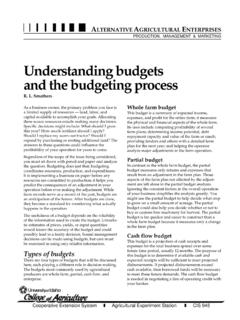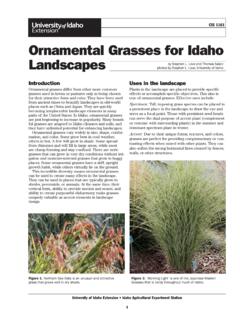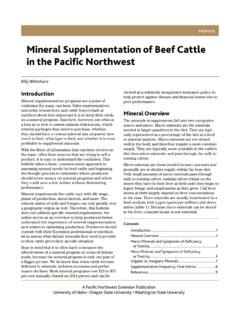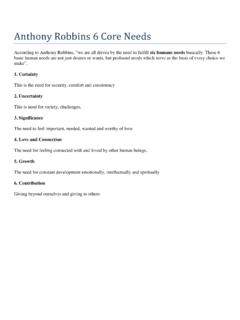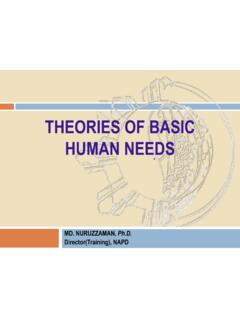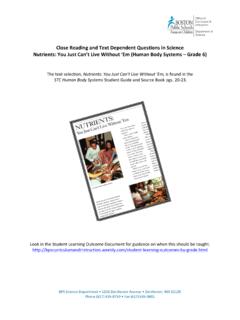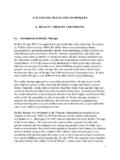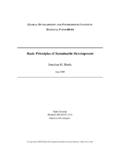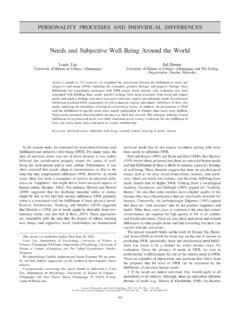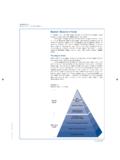Transcription of BUL 870 Methods for Conducting an Educational …
1 Methods for Conducting an Educational needs AssessmentGuidelines for Cooperative Extension System ProfessionalsBy Paul F. McCawleyBUL 870 PAGE 2 WHAT IS A needs assessment ? ..p 3 Direct and indirect assessments ..p 3 Six steps for a needs assessment ..p 4 Objectives ..p 4 Describe the target audience ..p 5 INSTITUTIONAL APPROVAL ..p 5 FOUR DATA COLLECTING Methods ..p 6 Samle procedure ..p 6 Sample size, design ..p 6 Table 1, Sample size for validity ..p 7 When to stratify sample ..p 71. SURVEYS ..p 8 Written surveys, questionnaires ..p 8 Oral, telephone surveys ..p 8 Survey procedures ..p 9 Create survey instrument 14 steps ..p 9 Ten question-writing tips ..p 10 Pilot tests: Refine instrument ..p 10 Conduct survey ..p 11 Analyze data ..p 122. INTERVIEWS ..p 13 Interview procedures ..p 13 Analyze interview data ..p 143. FOCUS GROUPS ..p 14 Focus group procedures ..p 15 Choose a method ..p 15 Choose participants.
2 P 15 Logistics ..p 16 Describe questions, topics ..p 16 Select moderators ..p 17 Timeline ..p 17 Contact perspective participants ..p 17 Participant incentives ..p 17 Manage focus group sessions ..p 17 Kinds of questions to ask ..p 18 Analyze data ..p 18 Analysis tips ..p 194. WORKING GROUPS ..p 19 Uses of working groups ..p 20 Facilitator role ..p 20 Nominal Group Technique (NGT) ..p 21 Appropriate uses ..p 21 Materials and logistics ..p 21 Steps for Conducting NGT ..p 21 Introduction: Frame the question ..p 21 Brainstorm: the nominal phase ..p 21 Discuss: the clarification phase ..p 22 Decide: the voting phase ..p 22 Tips ..p 23 REFERENCES ..p 23 ABOUT THE AUTHOR Paul F. McCawleyhas served since 1999 as AssociateDirector of University of Idaho Extension. In 2004 heled development, implementation, and analysis of thebiggest survey in the history of University of IdahoExtension, a statewide survey to determine UI Exten-sion s impact on the state and to determine greatestneeds in the years 3 WHAT IS A needs assessment , AND WHY CONDUCT ONE?
3 A needs assessment is a systematic approach to study-ing the state of knowledge, ability, interest, or attitudeof a defined audience or group involving a particularsubject. Cooperative Extension System professionals useneeds assessments to learn about important issues andproblems faced by our public in order to design effectiveeducational programs. Programs and products that specifically target docu-mented needs are inherently effective and marketable. Aneeds assessment also provides a method to learn whathas already been done and what gaps in learning allows the educator to make informed decisionsabout needed investments, thereby extending the reachand impact of Educational programming. For extension, the goals of needs assessment are nearlyalways the same. The first goal is to learn what our audi-ence already knows and thinks, so that we can deter-mine what Educational products and services areneeded. A second goal is to understand what we can doto make our Educational products more accessible,acceptable, and useful to our clientele.
4 A needs assessment , thoughtfully performed, providesthe following: Impact. Insights about how education and training canimpact your audience; Approaches. Knowledge about Educational approaches that may be most effective; Awarenessof existing programs and of gaps in avail-able training to enable efficient use of resources; Outcomes. Information about the current situationthat can be used to document outcomes; Demand. Knowledge about the potential demand forfuture programs and products; Credibilitythat the program is serving the target audi-ence, an important part of communicating greatercompetence and professionalism to funding authori-ties who want to know a program or product s needs assessment is conducted so the target audiencecan verify its own level of knowledge and skill, its inter-ests and opinions, or its learning habits and and analyzing needs assessment data allowsthe investigator to describe the gap between what exists and what is needed.
5 Filling that gap becomes thepurpose of the next generation of Educational servicesand and indirect assessmentsA direct needs assessment is accomplished throughformal research that gathers data from clientele. Anindirect approach uses secondary data or asks surrogates(advisors) for their opinions about priority needs andissues. The direct assessment will result in data that ismore specific to the needs of individuals, and it can bequantitative in terms of probability and , direct research requires considerably moreresources to design and also requires institutionalapproval to conduct. Direct assessment should beconducted periodically for major program efforts. An indirect assessmentcan be conducted at any timewhen an advisory committee is meeting and does notrequire the same level of investment in the design,implementation, and analysis. However, even for a non-formal assessment , if the results are to be credible,procedures must be followed, and findings must be carefully needs assessment research helps docu-ment actual problems and deficiencies.
6 With the needsassessment in hand, an educator can 1) verify and describethe current situation, 2) explain how the program willaddress that need, and 3) describe the expected impactsof the program ( , build a logic model). A needs assessment allows educators to demonstratethe foundation for their logic model to potential partnersor funders. Because most funding sources insist that aproject be evaluated, the information in a needs assess-ment forms the basis for a program evaluation. Whenthe intervention results in measurable change, projectmanagers will know whether they have succeeded and/orknow what steps need to be taken 4 While goals for needs assessments are similar, thepurposes to conduct needs assessments vary and willinfluence how the project is approached. Extension isrequired by statute to consider stakeholder input as partof the design and delivery of programs. There are alsocontractual agreements between state and local govern-ments that extension address locally relevant agencies and organizations may require aneeds assessment as a term of performance.
7 Because ofthese legal and contractual purposes for needs assess-ments, the procedures need to be valid and the assessments are also conducted simply to gener-ate better knowledge with which to make decisions. Ifbetter information is the sole purpose for Conducting aneeds assessment , the procedures may be less formal,although the steps to plan, gather, and analyze data arestill steps in Conducting a needs assessmentThe first step is to develop a plan. The assessment planbegins as a description of the what, when, who, how, andwhy of your project. This description becomes a plan fordesigning, Conducting , and evaluating a needs assess-ment. Seven components of a needs assessment planinclude: 1. Write objectives: What is it that you want to learnfrom the needs assessment ?2. Select audience: Who is the target audience? Whoseneeds are you measuring, and to whom will you givethe required information?3. Collect data: How will you collect data that will tellyou what you need to know?
8 Will you collect datadirectly from the target audience or indirectly?4. Select audience sample: How will you select asample of respondents who represent the target audience?5. Pick an instrument: What instruments and techniques will you use to collect data?6. Analyze data: How will you analyze the data youcollect?7. Follow-up: What will you do with information thatyou gain? Data gathering Methods by themselves arenot a needs assessment . For the process to becomplete, the needs assessment has to result in of a needs assessment :Which people need to know what?Various objectives of a needs assessment are based ontwo things: who is asking the questions (what is yourmission and responsibility?); and who is the target audience. The objectives will dictate how the needsassessment is to be designed and assessments can either document the currentsituation for a groupor for a target population. A needsassessment is often conducted for a specific group,organization, or business in order to improve effective-ness or productivity of the group related to its objectives relate to the objectives of theorganization.
9 For a company, organizational assessmentslearn how to close a training or performance gap (Gupta et al., 2007).For example, a business might seek ways to improvecustomer service, and the target audience includesemployees and customers of the business. Other examples of an organizational needs assessment mightinclude a school district investigating the most efficientuse of available teachers, or a volunteer organizationtrying to decide which fund-raising project to conductnext. In these examples, the target audiences (thosewho will provide the data) are teachers and/orparents/students in the district and the membership ofthe service organization. Extension professionals withopportunities to help organizations assess their needswill follow planning steps for a a needs assessment is conducted on behalf of thepublic (for the benefit of multiple individuals, but not aspecific group), then objectives tend to focus on what isneeded to improve the situation for individuals throughchanging knowledge, behavior, and/or conditions.
10 Acomprehensive needs assessment for such an audienceshould include objectives similar to those of a marketanalysis. In other words, it may not be enough to learnPAGE 5your audience s needs if audience members are notinterested in your recommended solution. The effortmust also determine what services and products willappeal to the audience. Objectives of a needs assessment for a target popula-tion, then, are not limited to information about theirexisting knowledge and skills. Objectives may alsorequire an investigation into the audience s perceivedsolutions, as well as their priorities and their you only ask stakeholders what their problems are, itfalls to you to determine what kinds of education willhelp address those problems. The limitation with an approach that does not ask theaudience for perceived solutions is that the interventionyou design may not be marketable to your audience. Ifyou ask stakeholders only what they want, you mayhave insufficient information with which to address theproblems that need solving.

